Exploring Trends in Global Business Environment: Collaboration Impact
VerifiedAdded on 2023/06/12
|11
|2698
|238
Report
AI Summary
This report examines the effectiveness of collaboration within the workplace and its impact on global and cross-functional efficiency. It discusses how collaborative resources invested by employees create value through informational, social, and personal resources. The report analyzes the importance of work redistribution in enhancing organizational efficiency, emphasizing behavioral changes, technology leveraging, and structural modifications. It also highlights the need for rewarding effective collaboration to motivate employees and improve performance. Furthermore, the report explores the benefits of leveraging technology and considering structural changes for gaining a competitive advantage and achieving business goals, ultimately leading to improved teamwork, communication, and business success. Desklib provides access to similar solved assignments and past papers for students.
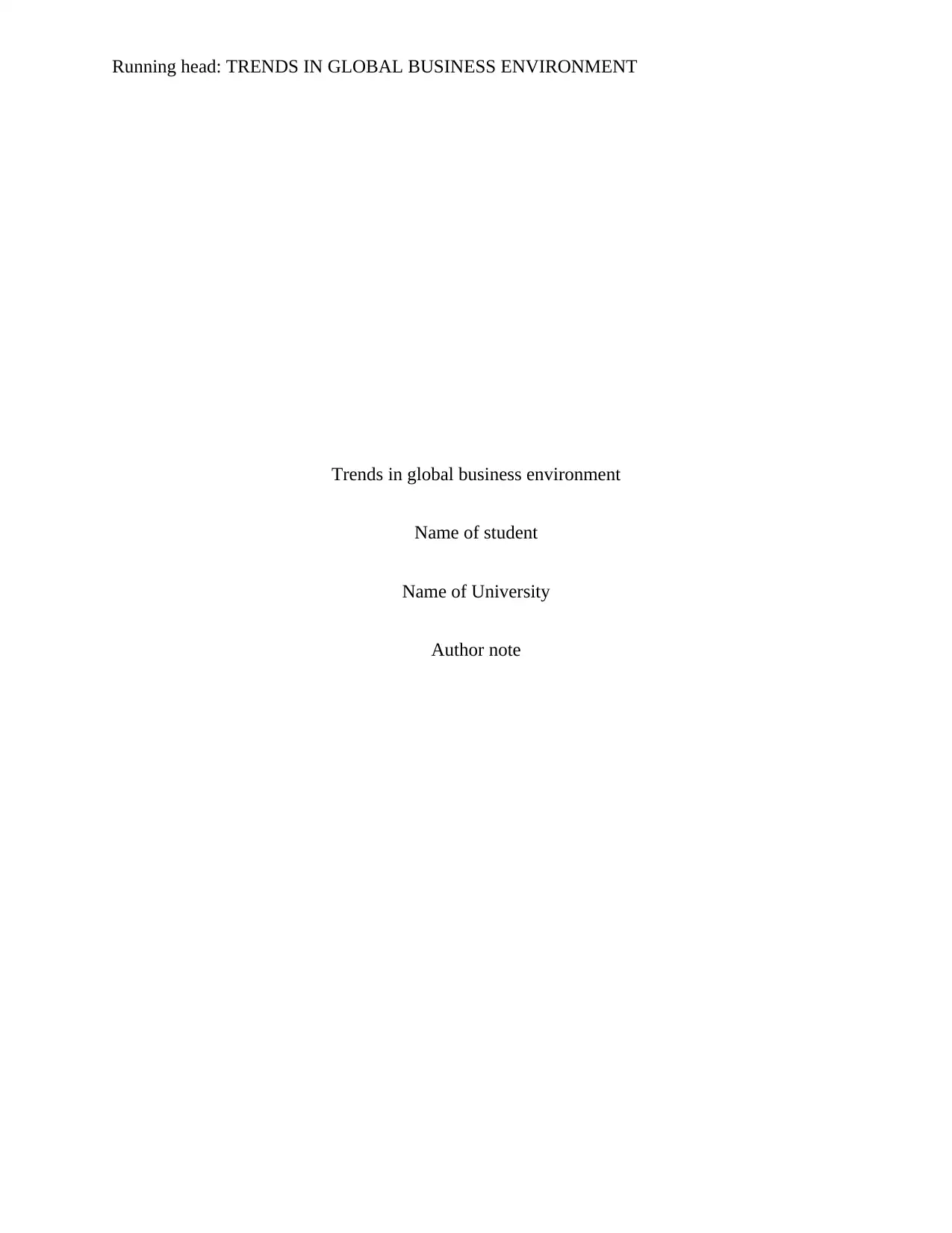
Running head: TRENDS IN GLOBAL BUSINESS ENVIRONMENT
Trends in global business environment
Name of student
Name of University
Author note
Trends in global business environment
Name of student
Name of University
Author note
Paraphrase This Document
Need a fresh take? Get an instant paraphrase of this document with our AI Paraphraser
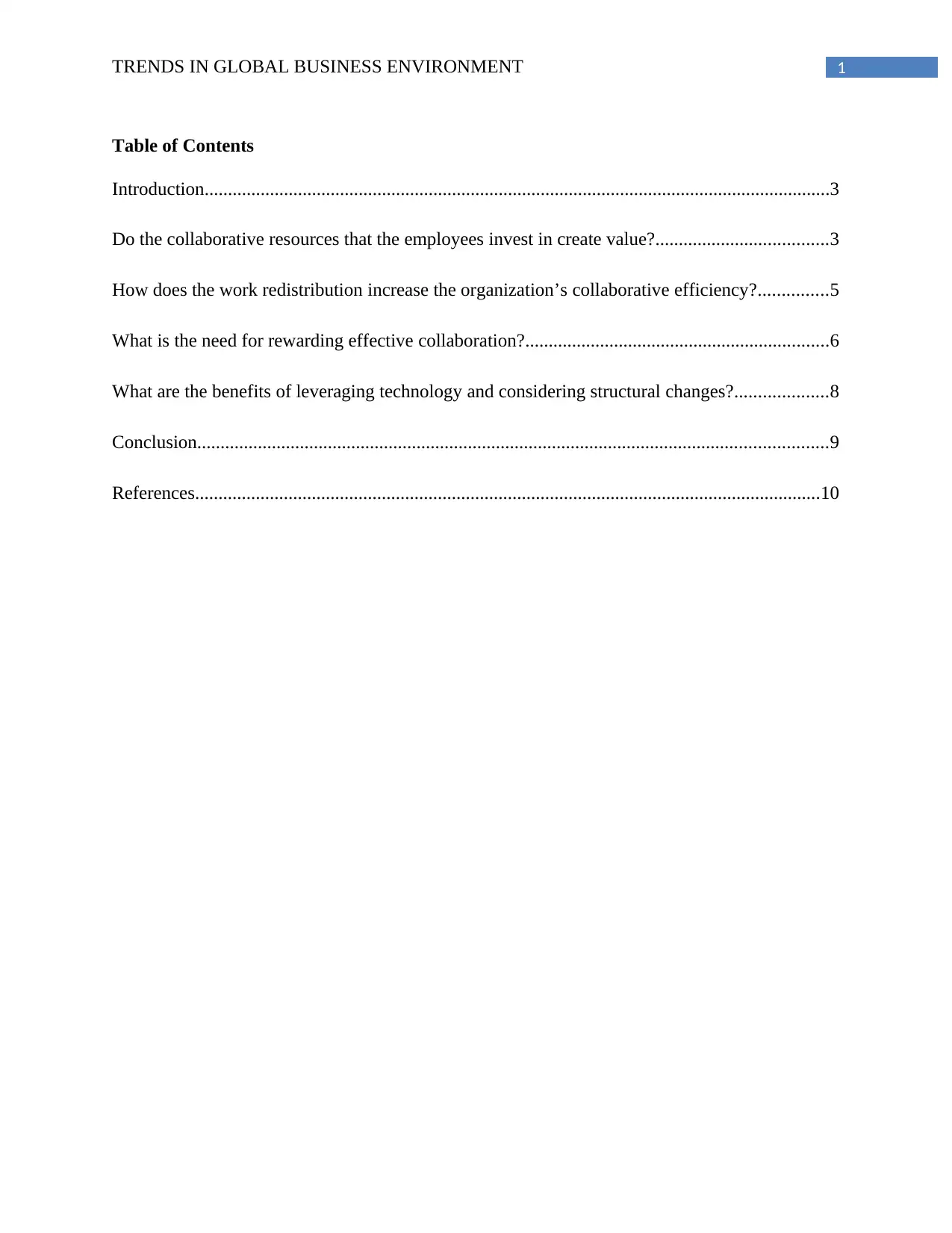
1TRENDS IN GLOBAL BUSINESS ENVIRONMENT
Table of Contents
Introduction......................................................................................................................................3
Do the collaborative resources that the employees invest in create value?.....................................3
How does the work redistribution increase the organization’s collaborative efficiency?...............5
What is the need for rewarding effective collaboration?.................................................................6
What are the benefits of leveraging technology and considering structural changes?....................8
Conclusion.......................................................................................................................................9
References......................................................................................................................................10
Table of Contents
Introduction......................................................................................................................................3
Do the collaborative resources that the employees invest in create value?.....................................3
How does the work redistribution increase the organization’s collaborative efficiency?...............5
What is the need for rewarding effective collaboration?.................................................................6
What are the benefits of leveraging technology and considering structural changes?....................8
Conclusion.......................................................................................................................................9
References......................................................................................................................................10
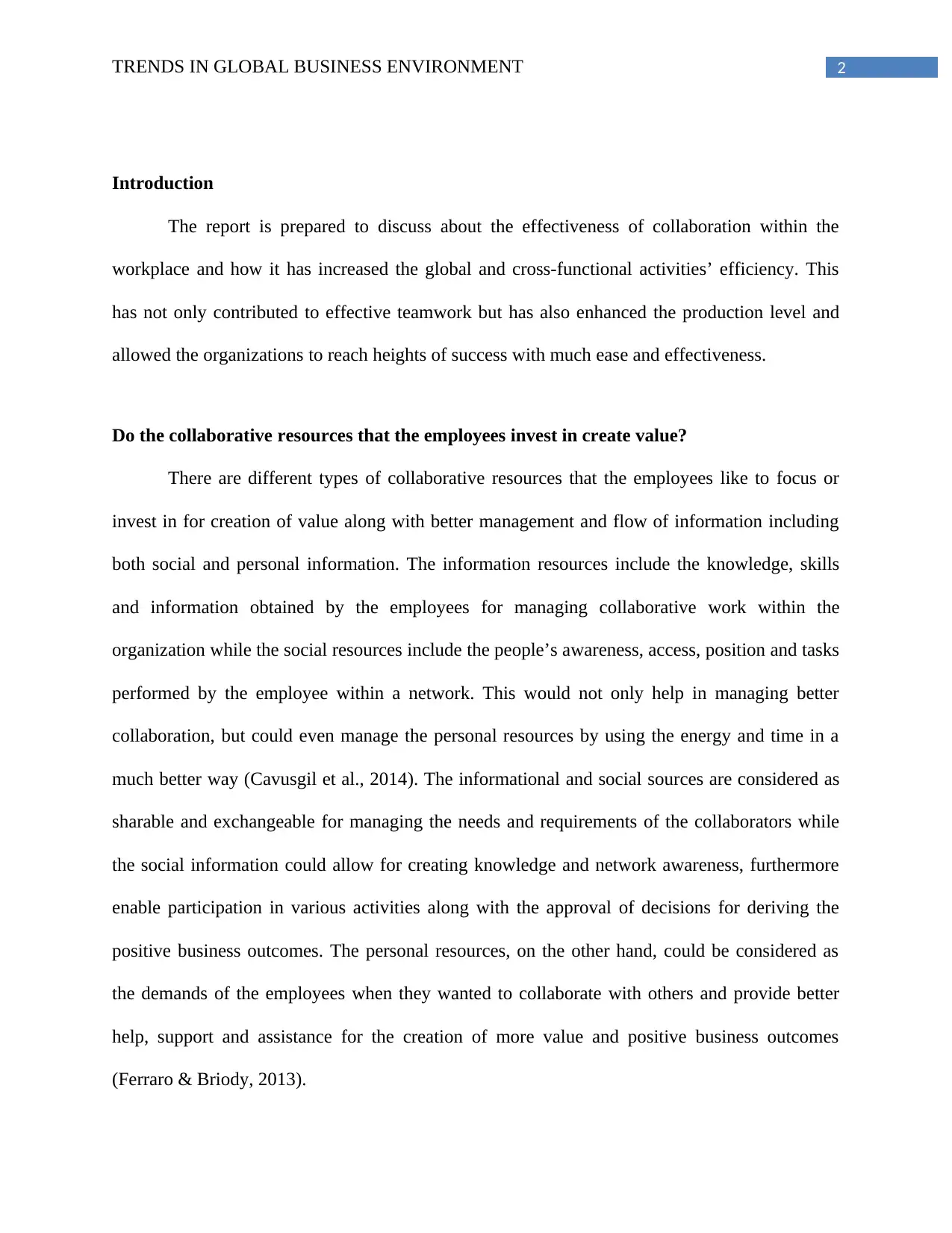
2TRENDS IN GLOBAL BUSINESS ENVIRONMENT
Introduction
The report is prepared to discuss about the effectiveness of collaboration within the
workplace and how it has increased the global and cross-functional activities’ efficiency. This
has not only contributed to effective teamwork but has also enhanced the production level and
allowed the organizations to reach heights of success with much ease and effectiveness.
Do the collaborative resources that the employees invest in create value?
There are different types of collaborative resources that the employees like to focus or
invest in for creation of value along with better management and flow of information including
both social and personal information. The information resources include the knowledge, skills
and information obtained by the employees for managing collaborative work within the
organization while the social resources include the people’s awareness, access, position and tasks
performed by the employee within a network. This would not only help in managing better
collaboration, but could even manage the personal resources by using the energy and time in a
much better way (Cavusgil et al., 2014). The informational and social sources are considered as
sharable and exchangeable for managing the needs and requirements of the collaborators while
the social information could allow for creating knowledge and network awareness, furthermore
enable participation in various activities along with the approval of decisions for deriving the
positive business outcomes. The personal resources, on the other hand, could be considered as
the demands of the employees when they wanted to collaborate with others and provide better
help, support and assistance for the creation of more value and positive business outcomes
(Ferraro & Briody, 2013).
Introduction
The report is prepared to discuss about the effectiveness of collaboration within the
workplace and how it has increased the global and cross-functional activities’ efficiency. This
has not only contributed to effective teamwork but has also enhanced the production level and
allowed the organizations to reach heights of success with much ease and effectiveness.
Do the collaborative resources that the employees invest in create value?
There are different types of collaborative resources that the employees like to focus or
invest in for creation of value along with better management and flow of information including
both social and personal information. The information resources include the knowledge, skills
and information obtained by the employees for managing collaborative work within the
organization while the social resources include the people’s awareness, access, position and tasks
performed by the employee within a network. This would not only help in managing better
collaboration, but could even manage the personal resources by using the energy and time in a
much better way (Cavusgil et al., 2014). The informational and social sources are considered as
sharable and exchangeable for managing the needs and requirements of the collaborators while
the social information could allow for creating knowledge and network awareness, furthermore
enable participation in various activities along with the approval of decisions for deriving the
positive business outcomes. The personal resources, on the other hand, could be considered as
the demands of the employees when they wanted to collaborate with others and provide better
help, support and assistance for the creation of more value and positive business outcomes
(Ferraro & Briody, 2013).
⊘ This is a preview!⊘
Do you want full access?
Subscribe today to unlock all pages.

Trusted by 1+ million students worldwide
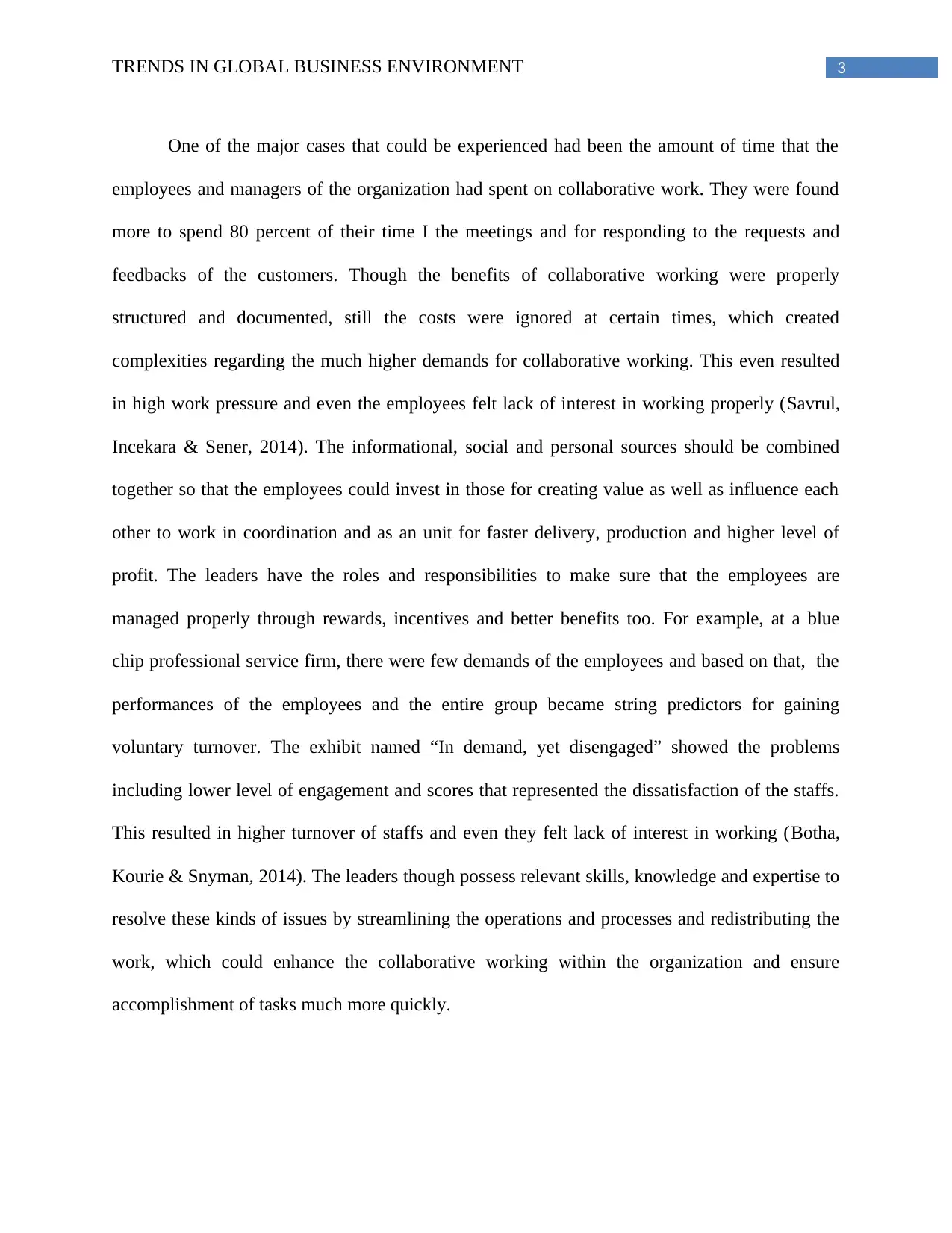
3TRENDS IN GLOBAL BUSINESS ENVIRONMENT
One of the major cases that could be experienced had been the amount of time that the
employees and managers of the organization had spent on collaborative work. They were found
more to spend 80 percent of their time I the meetings and for responding to the requests and
feedbacks of the customers. Though the benefits of collaborative working were properly
structured and documented, still the costs were ignored at certain times, which created
complexities regarding the much higher demands for collaborative working. This even resulted
in high work pressure and even the employees felt lack of interest in working properly (Savrul,
Incekara & Sener, 2014). The informational, social and personal sources should be combined
together so that the employees could invest in those for creating value as well as influence each
other to work in coordination and as an unit for faster delivery, production and higher level of
profit. The leaders have the roles and responsibilities to make sure that the employees are
managed properly through rewards, incentives and better benefits too. For example, at a blue
chip professional service firm, there were few demands of the employees and based on that, the
performances of the employees and the entire group became string predictors for gaining
voluntary turnover. The exhibit named “In demand, yet disengaged” showed the problems
including lower level of engagement and scores that represented the dissatisfaction of the staffs.
This resulted in higher turnover of staffs and even they felt lack of interest in working (Botha,
Kourie & Snyman, 2014). The leaders though possess relevant skills, knowledge and expertise to
resolve these kinds of issues by streamlining the operations and processes and redistributing the
work, which could enhance the collaborative working within the organization and ensure
accomplishment of tasks much more quickly.
One of the major cases that could be experienced had been the amount of time that the
employees and managers of the organization had spent on collaborative work. They were found
more to spend 80 percent of their time I the meetings and for responding to the requests and
feedbacks of the customers. Though the benefits of collaborative working were properly
structured and documented, still the costs were ignored at certain times, which created
complexities regarding the much higher demands for collaborative working. This even resulted
in high work pressure and even the employees felt lack of interest in working properly (Savrul,
Incekara & Sener, 2014). The informational, social and personal sources should be combined
together so that the employees could invest in those for creating value as well as influence each
other to work in coordination and as an unit for faster delivery, production and higher level of
profit. The leaders have the roles and responsibilities to make sure that the employees are
managed properly through rewards, incentives and better benefits too. For example, at a blue
chip professional service firm, there were few demands of the employees and based on that, the
performances of the employees and the entire group became string predictors for gaining
voluntary turnover. The exhibit named “In demand, yet disengaged” showed the problems
including lower level of engagement and scores that represented the dissatisfaction of the staffs.
This resulted in higher turnover of staffs and even they felt lack of interest in working (Botha,
Kourie & Snyman, 2014). The leaders though possess relevant skills, knowledge and expertise to
resolve these kinds of issues by streamlining the operations and processes and redistributing the
work, which could enhance the collaborative working within the organization and ensure
accomplishment of tasks much more quickly.
Paraphrase This Document
Need a fresh take? Get an instant paraphrase of this document with our AI Paraphraser
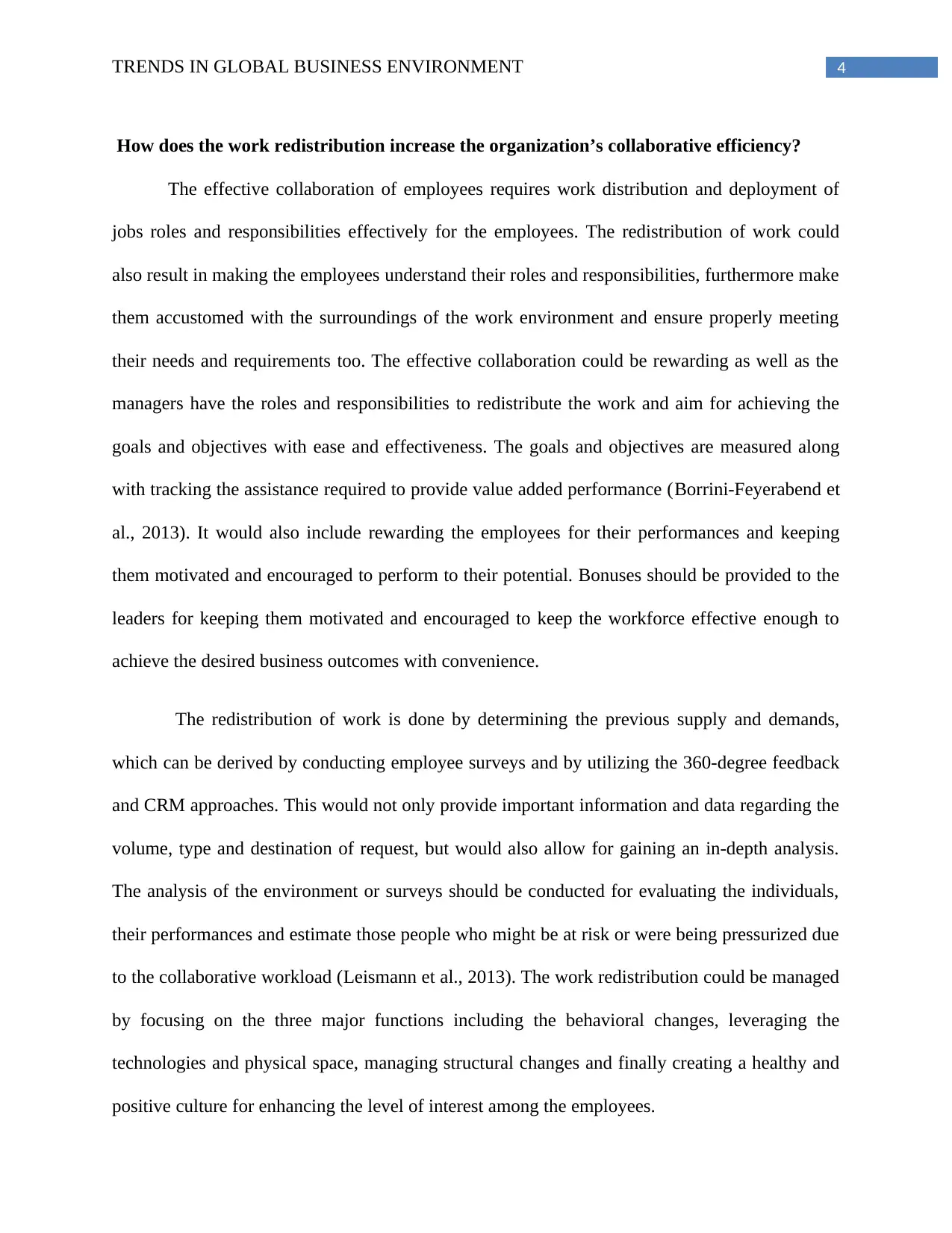
4TRENDS IN GLOBAL BUSINESS ENVIRONMENT
How does the work redistribution increase the organization’s collaborative efficiency?
The effective collaboration of employees requires work distribution and deployment of
jobs roles and responsibilities effectively for the employees. The redistribution of work could
also result in making the employees understand their roles and responsibilities, furthermore make
them accustomed with the surroundings of the work environment and ensure properly meeting
their needs and requirements too. The effective collaboration could be rewarding as well as the
managers have the roles and responsibilities to redistribute the work and aim for achieving the
goals and objectives with ease and effectiveness. The goals and objectives are measured along
with tracking the assistance required to provide value added performance (Borrini-Feyerabend et
al., 2013). It would also include rewarding the employees for their performances and keeping
them motivated and encouraged to perform to their potential. Bonuses should be provided to the
leaders for keeping them motivated and encouraged to keep the workforce effective enough to
achieve the desired business outcomes with convenience.
The redistribution of work is done by determining the previous supply and demands,
which can be derived by conducting employee surveys and by utilizing the 360-degree feedback
and CRM approaches. This would not only provide important information and data regarding the
volume, type and destination of request, but would also allow for gaining an in-depth analysis.
The analysis of the environment or surveys should be conducted for evaluating the individuals,
their performances and estimate those people who might be at risk or were being pressurized due
to the collaborative workload (Leismann et al., 2013). The work redistribution could be managed
by focusing on the three major functions including the behavioral changes, leveraging the
technologies and physical space, managing structural changes and finally creating a healthy and
positive culture for enhancing the level of interest among the employees.
How does the work redistribution increase the organization’s collaborative efficiency?
The effective collaboration of employees requires work distribution and deployment of
jobs roles and responsibilities effectively for the employees. The redistribution of work could
also result in making the employees understand their roles and responsibilities, furthermore make
them accustomed with the surroundings of the work environment and ensure properly meeting
their needs and requirements too. The effective collaboration could be rewarding as well as the
managers have the roles and responsibilities to redistribute the work and aim for achieving the
goals and objectives with ease and effectiveness. The goals and objectives are measured along
with tracking the assistance required to provide value added performance (Borrini-Feyerabend et
al., 2013). It would also include rewarding the employees for their performances and keeping
them motivated and encouraged to perform to their potential. Bonuses should be provided to the
leaders for keeping them motivated and encouraged to keep the workforce effective enough to
achieve the desired business outcomes with convenience.
The redistribution of work is done by determining the previous supply and demands,
which can be derived by conducting employee surveys and by utilizing the 360-degree feedback
and CRM approaches. This would not only provide important information and data regarding the
volume, type and destination of request, but would also allow for gaining an in-depth analysis.
The analysis of the environment or surveys should be conducted for evaluating the individuals,
their performances and estimate those people who might be at risk or were being pressurized due
to the collaborative workload (Leismann et al., 2013). The work redistribution could be managed
by focusing on the three major functions including the behavioral changes, leveraging the
technologies and physical space, managing structural changes and finally creating a healthy and
positive culture for enhancing the level of interest among the employees.
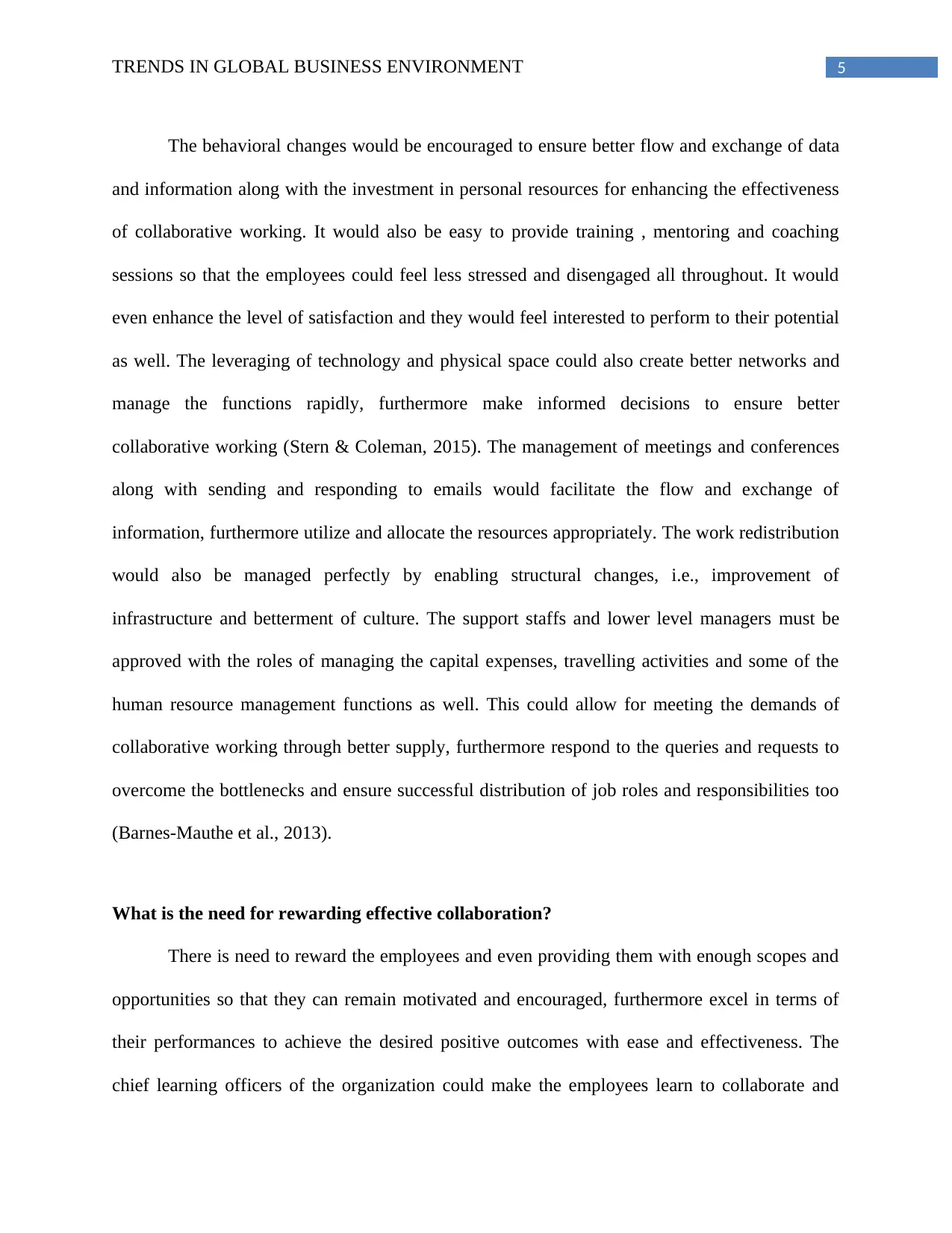
5TRENDS IN GLOBAL BUSINESS ENVIRONMENT
The behavioral changes would be encouraged to ensure better flow and exchange of data
and information along with the investment in personal resources for enhancing the effectiveness
of collaborative working. It would also be easy to provide training , mentoring and coaching
sessions so that the employees could feel less stressed and disengaged all throughout. It would
even enhance the level of satisfaction and they would feel interested to perform to their potential
as well. The leveraging of technology and physical space could also create better networks and
manage the functions rapidly, furthermore make informed decisions to ensure better
collaborative working (Stern & Coleman, 2015). The management of meetings and conferences
along with sending and responding to emails would facilitate the flow and exchange of
information, furthermore utilize and allocate the resources appropriately. The work redistribution
would also be managed perfectly by enabling structural changes, i.e., improvement of
infrastructure and betterment of culture. The support staffs and lower level managers must be
approved with the roles of managing the capital expenses, travelling activities and some of the
human resource management functions as well. This could allow for meeting the demands of
collaborative working through better supply, furthermore respond to the queries and requests to
overcome the bottlenecks and ensure successful distribution of job roles and responsibilities too
(Barnes-Mauthe et al., 2013).
What is the need for rewarding effective collaboration?
There is need to reward the employees and even providing them with enough scopes and
opportunities so that they can remain motivated and encouraged, furthermore excel in terms of
their performances to achieve the desired positive outcomes with ease and effectiveness. The
chief learning officers of the organization could make the employees learn to collaborate and
The behavioral changes would be encouraged to ensure better flow and exchange of data
and information along with the investment in personal resources for enhancing the effectiveness
of collaborative working. It would also be easy to provide training , mentoring and coaching
sessions so that the employees could feel less stressed and disengaged all throughout. It would
even enhance the level of satisfaction and they would feel interested to perform to their potential
as well. The leveraging of technology and physical space could also create better networks and
manage the functions rapidly, furthermore make informed decisions to ensure better
collaborative working (Stern & Coleman, 2015). The management of meetings and conferences
along with sending and responding to emails would facilitate the flow and exchange of
information, furthermore utilize and allocate the resources appropriately. The work redistribution
would also be managed perfectly by enabling structural changes, i.e., improvement of
infrastructure and betterment of culture. The support staffs and lower level managers must be
approved with the roles of managing the capital expenses, travelling activities and some of the
human resource management functions as well. This could allow for meeting the demands of
collaborative working through better supply, furthermore respond to the queries and requests to
overcome the bottlenecks and ensure successful distribution of job roles and responsibilities too
(Barnes-Mauthe et al., 2013).
What is the need for rewarding effective collaboration?
There is need to reward the employees and even providing them with enough scopes and
opportunities so that they can remain motivated and encouraged, furthermore excel in terms of
their performances to achieve the desired positive outcomes with ease and effectiveness. The
chief learning officers of the organization could make the employees learn to collaborate and
⊘ This is a preview!⊘
Do you want full access?
Subscribe today to unlock all pages.

Trusted by 1+ million students worldwide
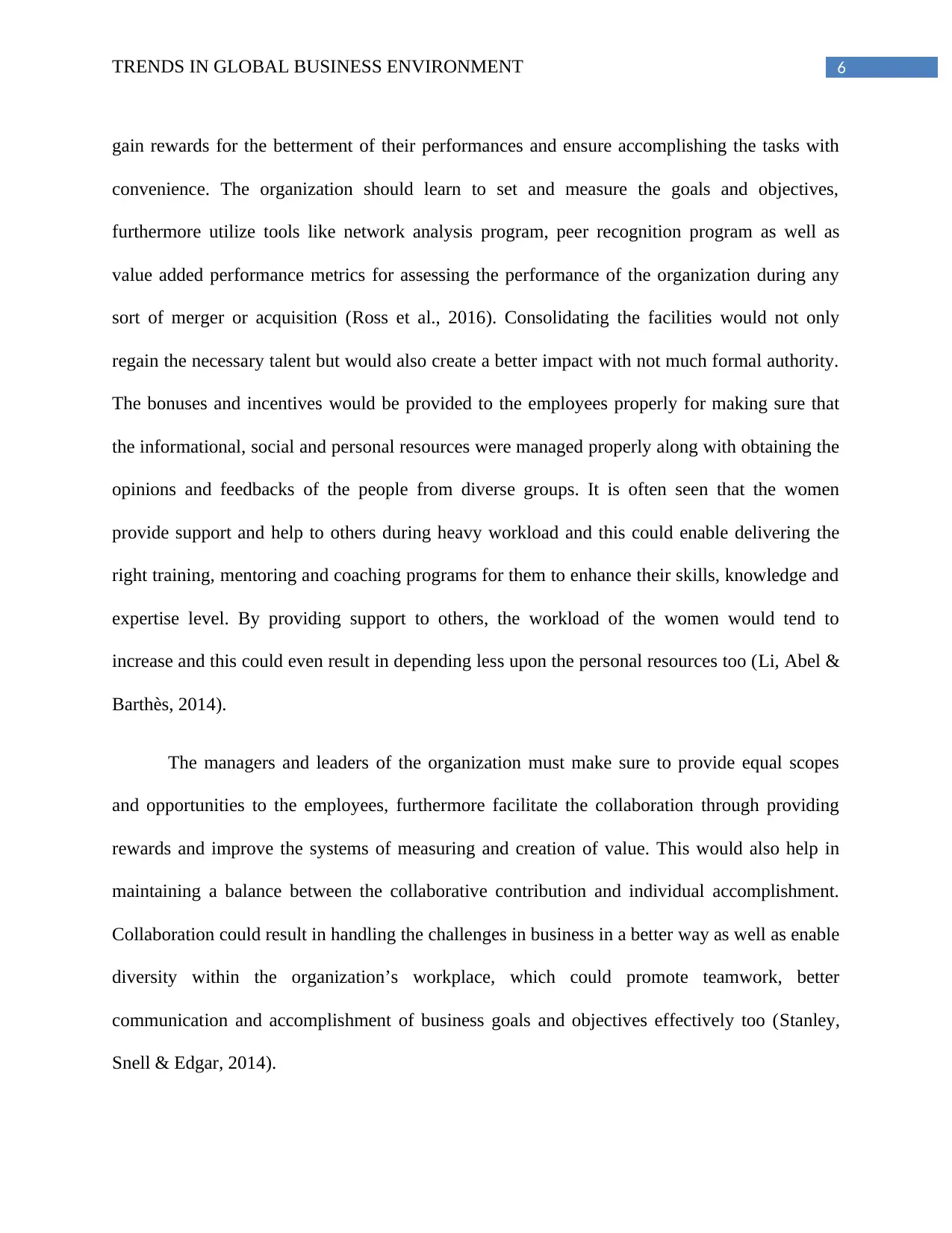
6TRENDS IN GLOBAL BUSINESS ENVIRONMENT
gain rewards for the betterment of their performances and ensure accomplishing the tasks with
convenience. The organization should learn to set and measure the goals and objectives,
furthermore utilize tools like network analysis program, peer recognition program as well as
value added performance metrics for assessing the performance of the organization during any
sort of merger or acquisition (Ross et al., 2016). Consolidating the facilities would not only
regain the necessary talent but would also create a better impact with not much formal authority.
The bonuses and incentives would be provided to the employees properly for making sure that
the informational, social and personal resources were managed properly along with obtaining the
opinions and feedbacks of the people from diverse groups. It is often seen that the women
provide support and help to others during heavy workload and this could enable delivering the
right training, mentoring and coaching programs for them to enhance their skills, knowledge and
expertise level. By providing support to others, the workload of the women would tend to
increase and this could even result in depending less upon the personal resources too (Li, Abel &
Barthès, 2014).
The managers and leaders of the organization must make sure to provide equal scopes
and opportunities to the employees, furthermore facilitate the collaboration through providing
rewards and improve the systems of measuring and creation of value. This would also help in
maintaining a balance between the collaborative contribution and individual accomplishment.
Collaboration could result in handling the challenges in business in a better way as well as enable
diversity within the organization’s workplace, which could promote teamwork, better
communication and accomplishment of business goals and objectives effectively too (Stanley,
Snell & Edgar, 2014).
gain rewards for the betterment of their performances and ensure accomplishing the tasks with
convenience. The organization should learn to set and measure the goals and objectives,
furthermore utilize tools like network analysis program, peer recognition program as well as
value added performance metrics for assessing the performance of the organization during any
sort of merger or acquisition (Ross et al., 2016). Consolidating the facilities would not only
regain the necessary talent but would also create a better impact with not much formal authority.
The bonuses and incentives would be provided to the employees properly for making sure that
the informational, social and personal resources were managed properly along with obtaining the
opinions and feedbacks of the people from diverse groups. It is often seen that the women
provide support and help to others during heavy workload and this could enable delivering the
right training, mentoring and coaching programs for them to enhance their skills, knowledge and
expertise level. By providing support to others, the workload of the women would tend to
increase and this could even result in depending less upon the personal resources too (Li, Abel &
Barthès, 2014).
The managers and leaders of the organization must make sure to provide equal scopes
and opportunities to the employees, furthermore facilitate the collaboration through providing
rewards and improve the systems of measuring and creation of value. This would also help in
maintaining a balance between the collaborative contribution and individual accomplishment.
Collaboration could result in handling the challenges in business in a better way as well as enable
diversity within the organization’s workplace, which could promote teamwork, better
communication and accomplishment of business goals and objectives effectively too (Stanley,
Snell & Edgar, 2014).
Paraphrase This Document
Need a fresh take? Get an instant paraphrase of this document with our AI Paraphraser
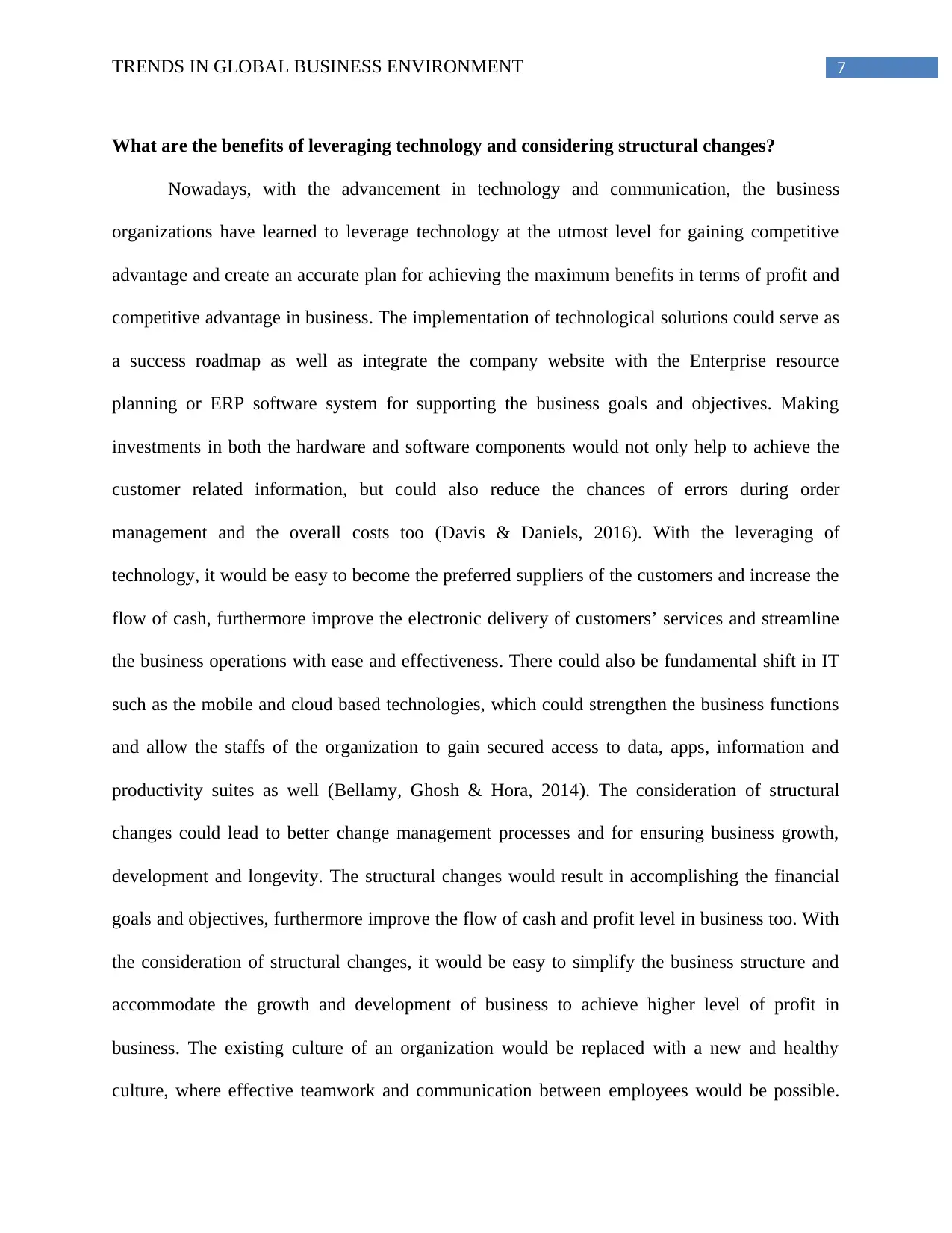
7TRENDS IN GLOBAL BUSINESS ENVIRONMENT
What are the benefits of leveraging technology and considering structural changes?
Nowadays, with the advancement in technology and communication, the business
organizations have learned to leverage technology at the utmost level for gaining competitive
advantage and create an accurate plan for achieving the maximum benefits in terms of profit and
competitive advantage in business. The implementation of technological solutions could serve as
a success roadmap as well as integrate the company website with the Enterprise resource
planning or ERP software system for supporting the business goals and objectives. Making
investments in both the hardware and software components would not only help to achieve the
customer related information, but could also reduce the chances of errors during order
management and the overall costs too (Davis & Daniels, 2016). With the leveraging of
technology, it would be easy to become the preferred suppliers of the customers and increase the
flow of cash, furthermore improve the electronic delivery of customers’ services and streamline
the business operations with ease and effectiveness. There could also be fundamental shift in IT
such as the mobile and cloud based technologies, which could strengthen the business functions
and allow the staffs of the organization to gain secured access to data, apps, information and
productivity suites as well (Bellamy, Ghosh & Hora, 2014). The consideration of structural
changes could lead to better change management processes and for ensuring business growth,
development and longevity. The structural changes would result in accomplishing the financial
goals and objectives, furthermore improve the flow of cash and profit level in business too. With
the consideration of structural changes, it would be easy to simplify the business structure and
accommodate the growth and development of business to achieve higher level of profit in
business. The existing culture of an organization would be replaced with a new and healthy
culture, where effective teamwork and communication between employees would be possible.
What are the benefits of leveraging technology and considering structural changes?
Nowadays, with the advancement in technology and communication, the business
organizations have learned to leverage technology at the utmost level for gaining competitive
advantage and create an accurate plan for achieving the maximum benefits in terms of profit and
competitive advantage in business. The implementation of technological solutions could serve as
a success roadmap as well as integrate the company website with the Enterprise resource
planning or ERP software system for supporting the business goals and objectives. Making
investments in both the hardware and software components would not only help to achieve the
customer related information, but could also reduce the chances of errors during order
management and the overall costs too (Davis & Daniels, 2016). With the leveraging of
technology, it would be easy to become the preferred suppliers of the customers and increase the
flow of cash, furthermore improve the electronic delivery of customers’ services and streamline
the business operations with ease and effectiveness. There could also be fundamental shift in IT
such as the mobile and cloud based technologies, which could strengthen the business functions
and allow the staffs of the organization to gain secured access to data, apps, information and
productivity suites as well (Bellamy, Ghosh & Hora, 2014). The consideration of structural
changes could lead to better change management processes and for ensuring business growth,
development and longevity. The structural changes would result in accomplishing the financial
goals and objectives, furthermore improve the flow of cash and profit level in business too. With
the consideration of structural changes, it would be easy to simplify the business structure and
accommodate the growth and development of business to achieve higher level of profit in
business. The existing culture of an organization would be replaced with a new and healthy
culture, where effective teamwork and communication between employees would be possible.
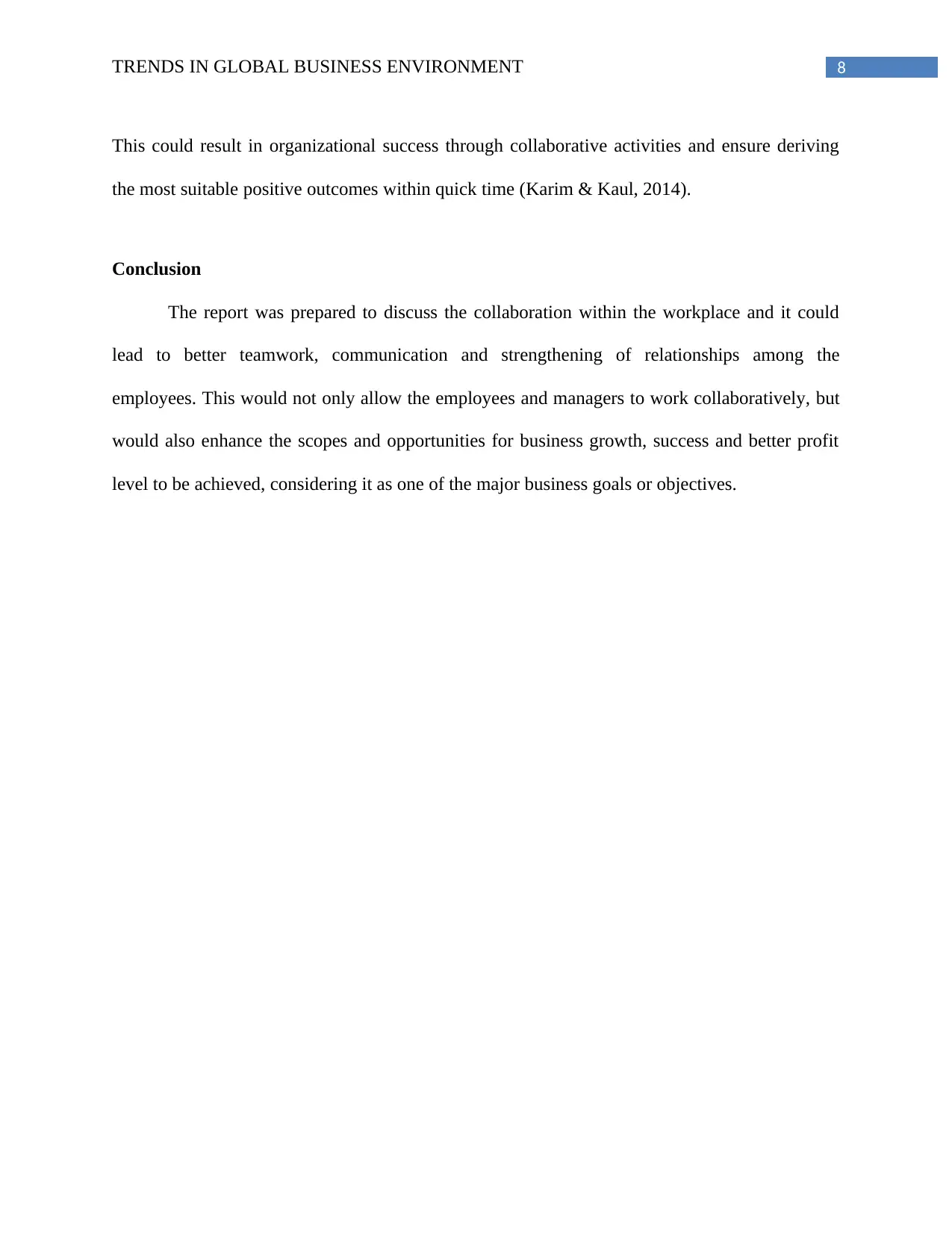
8TRENDS IN GLOBAL BUSINESS ENVIRONMENT
This could result in organizational success through collaborative activities and ensure deriving
the most suitable positive outcomes within quick time (Karim & Kaul, 2014).
Conclusion
The report was prepared to discuss the collaboration within the workplace and it could
lead to better teamwork, communication and strengthening of relationships among the
employees. This would not only allow the employees and managers to work collaboratively, but
would also enhance the scopes and opportunities for business growth, success and better profit
level to be achieved, considering it as one of the major business goals or objectives.
This could result in organizational success through collaborative activities and ensure deriving
the most suitable positive outcomes within quick time (Karim & Kaul, 2014).
Conclusion
The report was prepared to discuss the collaboration within the workplace and it could
lead to better teamwork, communication and strengthening of relationships among the
employees. This would not only allow the employees and managers to work collaboratively, but
would also enhance the scopes and opportunities for business growth, success and better profit
level to be achieved, considering it as one of the major business goals or objectives.
⊘ This is a preview!⊘
Do you want full access?
Subscribe today to unlock all pages.

Trusted by 1+ million students worldwide
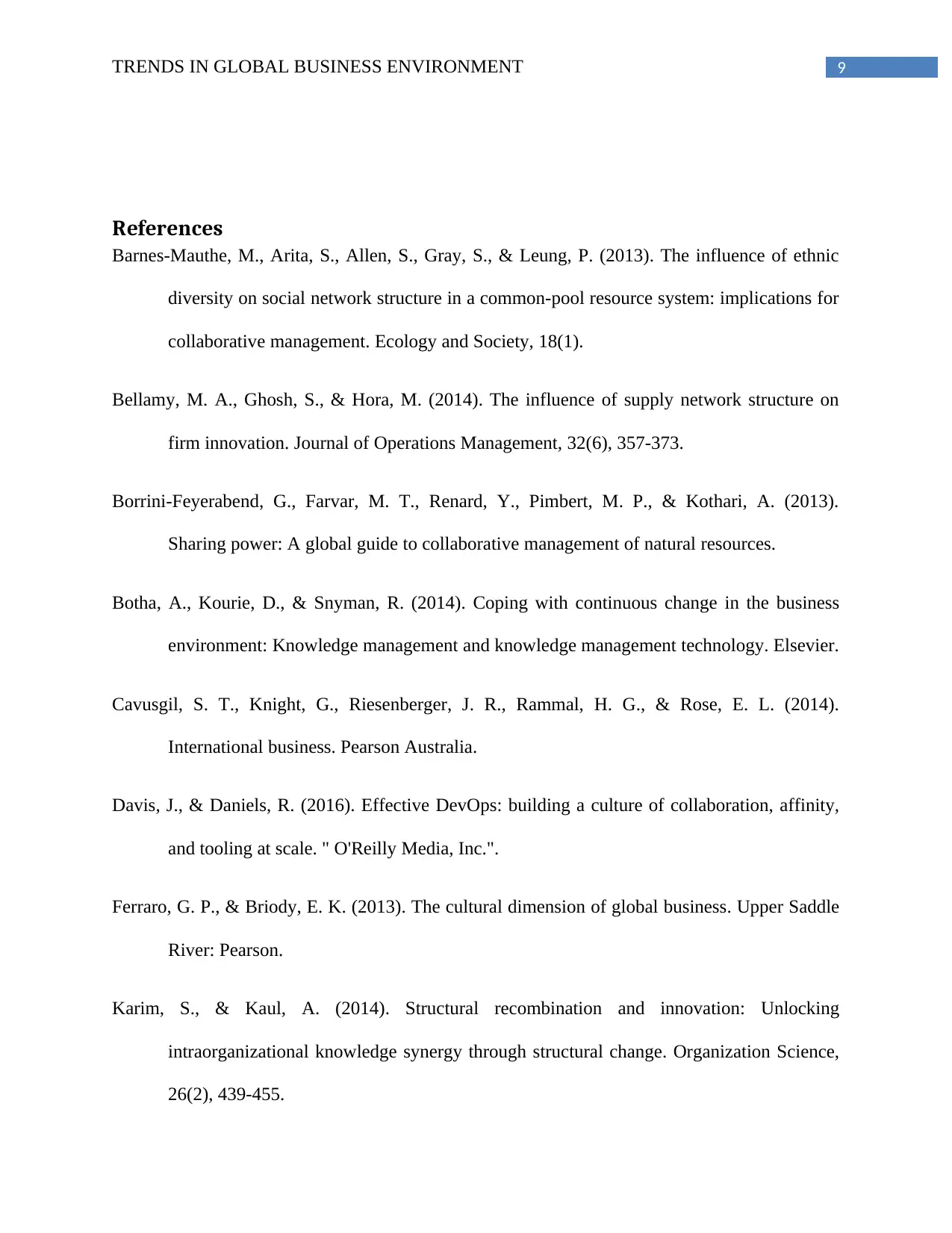
9TRENDS IN GLOBAL BUSINESS ENVIRONMENT
References
Barnes-Mauthe, M., Arita, S., Allen, S., Gray, S., & Leung, P. (2013). The influence of ethnic
diversity on social network structure in a common-pool resource system: implications for
collaborative management. Ecology and Society, 18(1).
Bellamy, M. A., Ghosh, S., & Hora, M. (2014). The influence of supply network structure on
firm innovation. Journal of Operations Management, 32(6), 357-373.
Borrini-Feyerabend, G., Farvar, M. T., Renard, Y., Pimbert, M. P., & Kothari, A. (2013).
Sharing power: A global guide to collaborative management of natural resources.
Botha, A., Kourie, D., & Snyman, R. (2014). Coping with continuous change in the business
environment: Knowledge management and knowledge management technology. Elsevier.
Cavusgil, S. T., Knight, G., Riesenberger, J. R., Rammal, H. G., & Rose, E. L. (2014).
International business. Pearson Australia.
Davis, J., & Daniels, R. (2016). Effective DevOps: building a culture of collaboration, affinity,
and tooling at scale. " O'Reilly Media, Inc.".
Ferraro, G. P., & Briody, E. K. (2013). The cultural dimension of global business. Upper Saddle
River: Pearson.
Karim, S., & Kaul, A. (2014). Structural recombination and innovation: Unlocking
intraorganizational knowledge synergy through structural change. Organization Science,
26(2), 439-455.
References
Barnes-Mauthe, M., Arita, S., Allen, S., Gray, S., & Leung, P. (2013). The influence of ethnic
diversity on social network structure in a common-pool resource system: implications for
collaborative management. Ecology and Society, 18(1).
Bellamy, M. A., Ghosh, S., & Hora, M. (2014). The influence of supply network structure on
firm innovation. Journal of Operations Management, 32(6), 357-373.
Borrini-Feyerabend, G., Farvar, M. T., Renard, Y., Pimbert, M. P., & Kothari, A. (2013).
Sharing power: A global guide to collaborative management of natural resources.
Botha, A., Kourie, D., & Snyman, R. (2014). Coping with continuous change in the business
environment: Knowledge management and knowledge management technology. Elsevier.
Cavusgil, S. T., Knight, G., Riesenberger, J. R., Rammal, H. G., & Rose, E. L. (2014).
International business. Pearson Australia.
Davis, J., & Daniels, R. (2016). Effective DevOps: building a culture of collaboration, affinity,
and tooling at scale. " O'Reilly Media, Inc.".
Ferraro, G. P., & Briody, E. K. (2013). The cultural dimension of global business. Upper Saddle
River: Pearson.
Karim, S., & Kaul, A. (2014). Structural recombination and innovation: Unlocking
intraorganizational knowledge synergy through structural change. Organization Science,
26(2), 439-455.
Paraphrase This Document
Need a fresh take? Get an instant paraphrase of this document with our AI Paraphraser
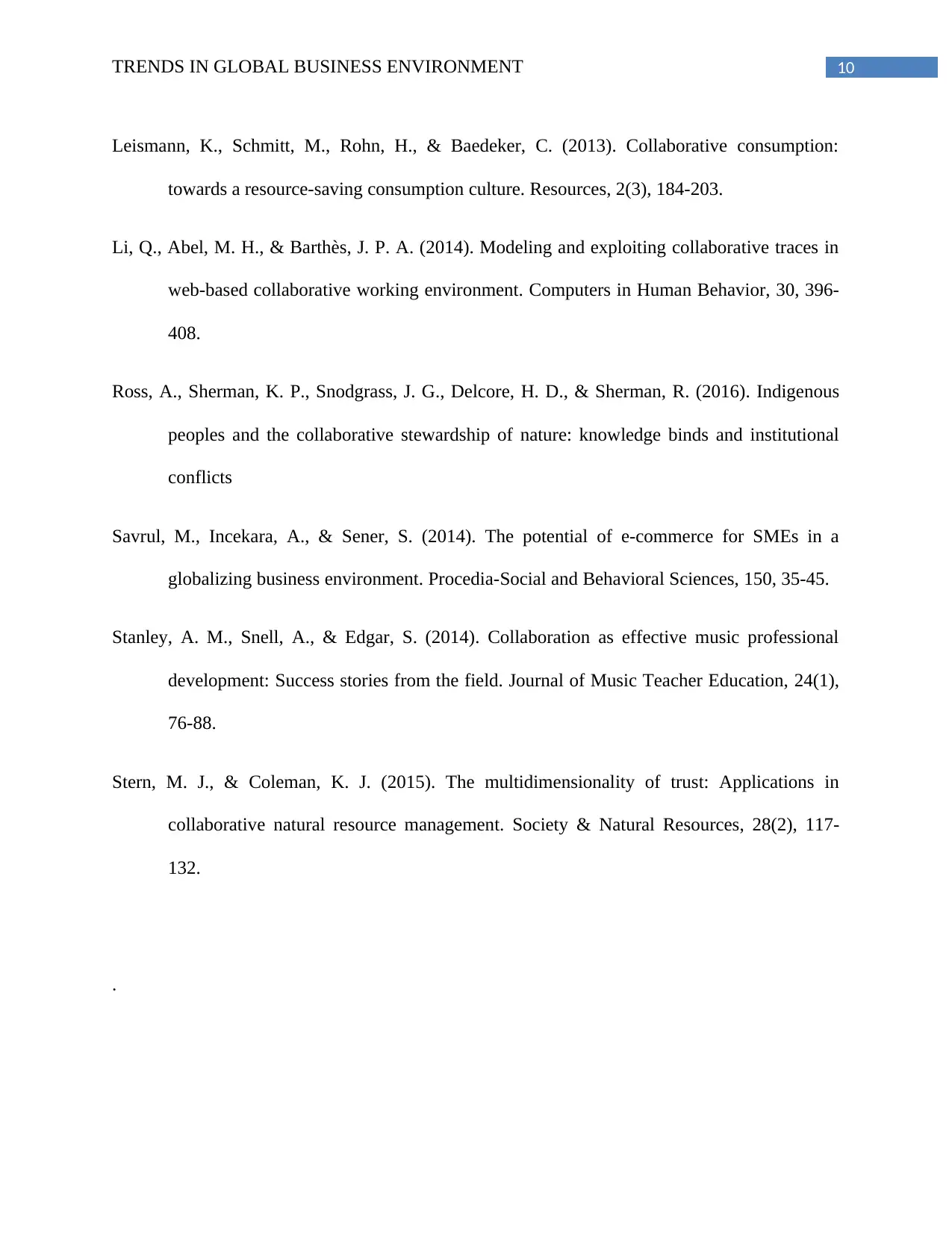
10TRENDS IN GLOBAL BUSINESS ENVIRONMENT
Leismann, K., Schmitt, M., Rohn, H., & Baedeker, C. (2013). Collaborative consumption:
towards a resource-saving consumption culture. Resources, 2(3), 184-203.
Li, Q., Abel, M. H., & Barthès, J. P. A. (2014). Modeling and exploiting collaborative traces in
web-based collaborative working environment. Computers in Human Behavior, 30, 396-
408.
Ross, A., Sherman, K. P., Snodgrass, J. G., Delcore, H. D., & Sherman, R. (2016). Indigenous
peoples and the collaborative stewardship of nature: knowledge binds and institutional
conflicts
Savrul, M., Incekara, A., & Sener, S. (2014). The potential of e-commerce for SMEs in a
globalizing business environment. Procedia-Social and Behavioral Sciences, 150, 35-45.
Stanley, A. M., Snell, A., & Edgar, S. (2014). Collaboration as effective music professional
development: Success stories from the field. Journal of Music Teacher Education, 24(1),
76-88.
Stern, M. J., & Coleman, K. J. (2015). The multidimensionality of trust: Applications in
collaborative natural resource management. Society & Natural Resources, 28(2), 117-
132.
.
Leismann, K., Schmitt, M., Rohn, H., & Baedeker, C. (2013). Collaborative consumption:
towards a resource-saving consumption culture. Resources, 2(3), 184-203.
Li, Q., Abel, M. H., & Barthès, J. P. A. (2014). Modeling and exploiting collaborative traces in
web-based collaborative working environment. Computers in Human Behavior, 30, 396-
408.
Ross, A., Sherman, K. P., Snodgrass, J. G., Delcore, H. D., & Sherman, R. (2016). Indigenous
peoples and the collaborative stewardship of nature: knowledge binds and institutional
conflicts
Savrul, M., Incekara, A., & Sener, S. (2014). The potential of e-commerce for SMEs in a
globalizing business environment. Procedia-Social and Behavioral Sciences, 150, 35-45.
Stanley, A. M., Snell, A., & Edgar, S. (2014). Collaboration as effective music professional
development: Success stories from the field. Journal of Music Teacher Education, 24(1),
76-88.
Stern, M. J., & Coleman, K. J. (2015). The multidimensionality of trust: Applications in
collaborative natural resource management. Society & Natural Resources, 28(2), 117-
132.
.
1 out of 11
Related Documents
Your All-in-One AI-Powered Toolkit for Academic Success.
+13062052269
info@desklib.com
Available 24*7 on WhatsApp / Email
![[object Object]](/_next/static/media/star-bottom.7253800d.svg)
Unlock your academic potential
Copyright © 2020–2025 A2Z Services. All Rights Reserved. Developed and managed by ZUCOL.





